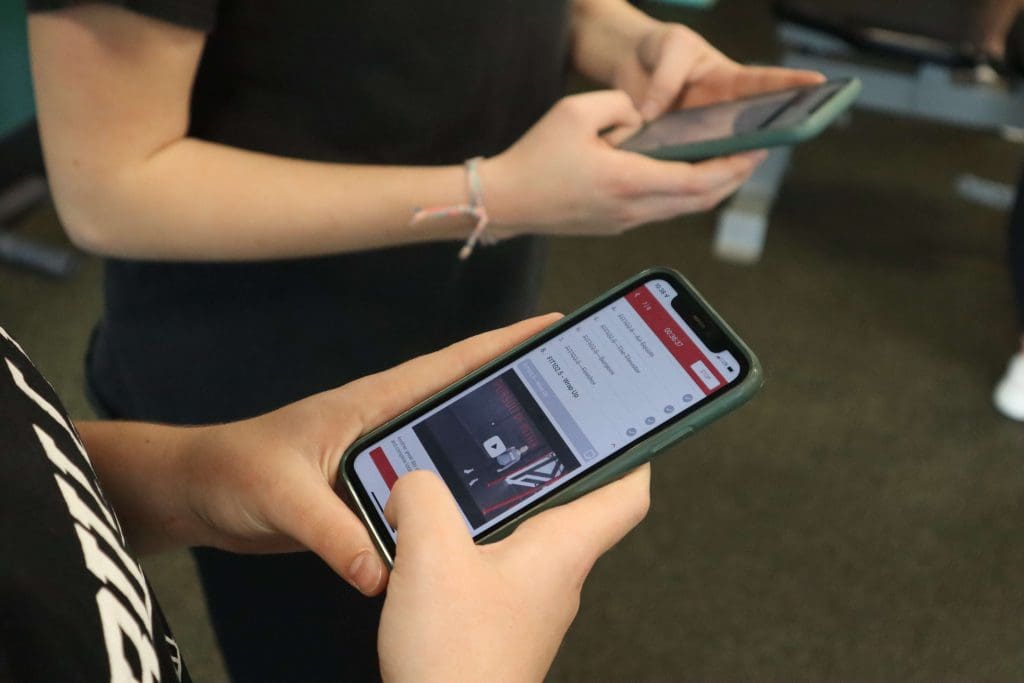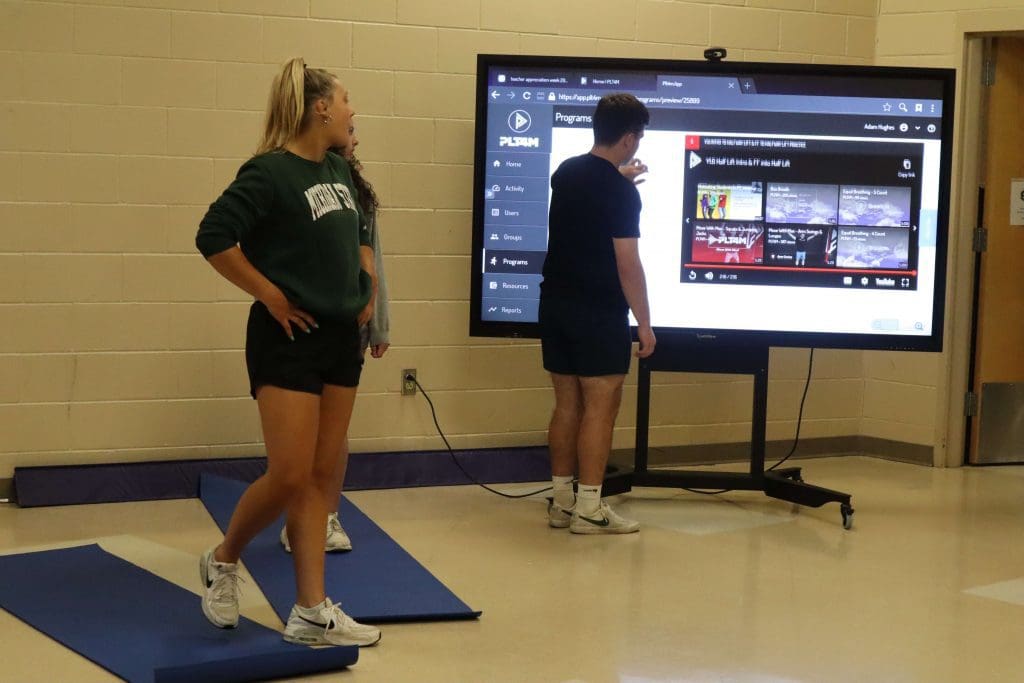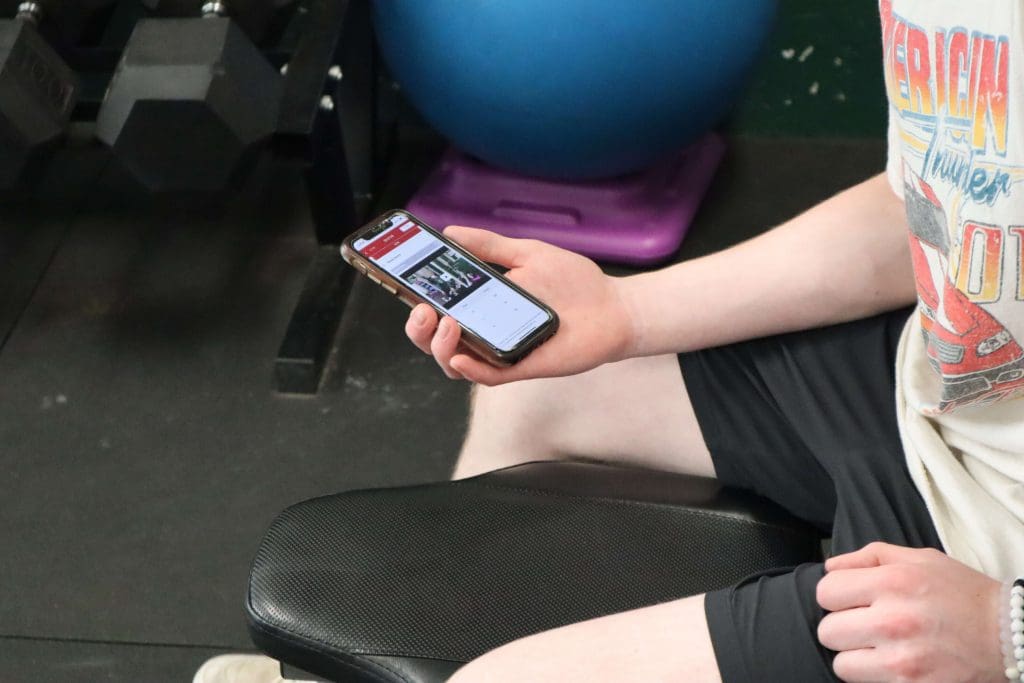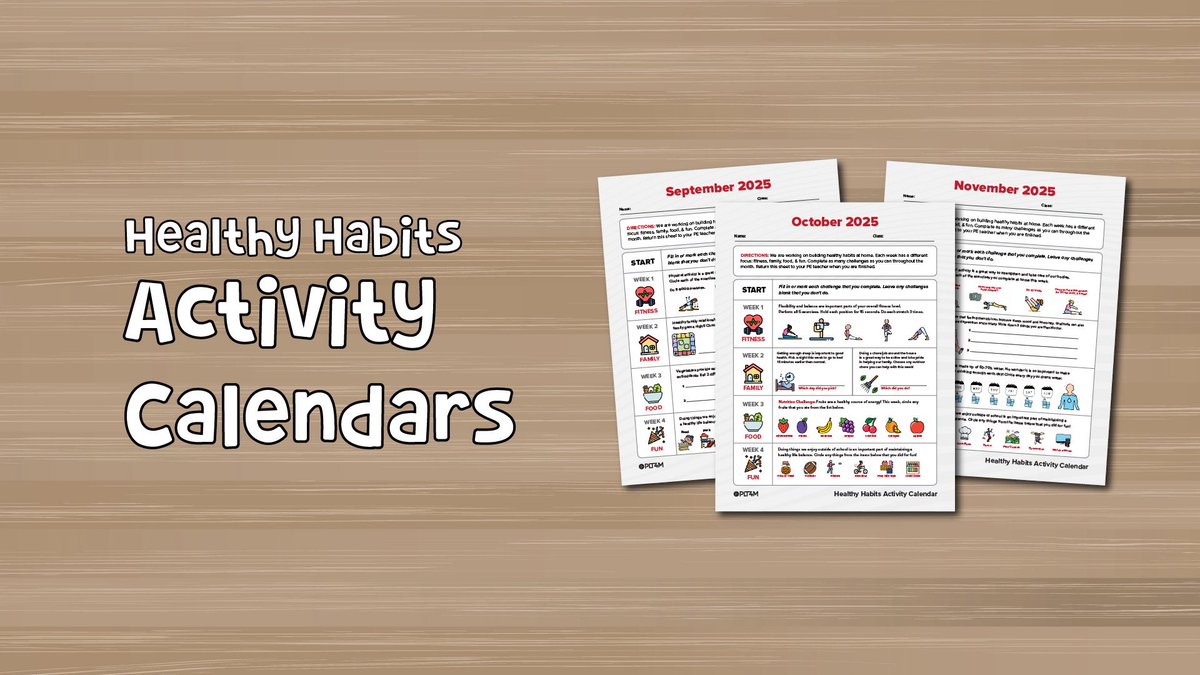About the Author:
Sean Fullerton is a former secondary physical education teacher and current Ph.D. student at the University of New Mexico in the Health, Exercise, and Sports Science Department. In this article, Sean explores technology use in physical education. Be on the lookout for lots of great content from Sean as he helps take the academic angle of physical education best practices.

Technology can be useful at enhancing teaching and learning in physical education by increasing physical activity (PA) levels (Melton et al., 2015), motivation (Melton et al., 2015) and motor performance (O’Loughlin et al., 2013). Technology use in physical education focusing on content knowledge can provide context for PE lessons, leading to a motivating learning environment for students (Østerlie, & Mehus, 2020).
Considerable research on technology use in physical education has focused on wearable digital technologies, mobile devices, computers, video, and recently app-based software (Bodsworth & Goodyear, 2017; Lee & Gao, 2020). Physical educators also often use technology for teacher productivity such as websites and e-documents (Baek et al., 2018).
Many teachers, even though tech savvy, may lack pedagogical skills necessary to integrate technology into their curriculum and instruction effectively. Barriers to technology use in physical education include familiarity with technology use for learning (Bodsworth & Goodyear, 2017), pedagogical knowledge and beliefs of the teacher (Baek et al., 2018), and student content knowledge.
Technology alone should not be thought of as a standalone strategy or focal point of instruction, but rather, it should aid the learning process (Sinelekov, 2012). Specific teaching strategies to accompany technology can be helpful for teachers to ensure efficacy. Below are five research-based strategies that can be applied by teachers looking to integrate technology to enhance their teaching.
Avoid integrating new technology and new content at the same time.
Technology should be integrated within an autonomy-supportive environment.
Goal setting and individualization should accompany fitness tracking
Use technology in physical education to promote student-centered learning
Technology use in physical education can be useful in building motor skills
Discover The Benefits of Using
Technology in Physical Education
Learn how physical education departments are benefiting from embracing technology in their classrooms
1) Avoid integrating new technology and new content at the same time.
Researchers found it difficult when students had to learn both new technology and pedagogical approach at the same time (Bodsworth & Goodyear, 2017). It is recommended that teachers focus on one at a time, either a new teaching strategy, or new technology.
For example, a teacher can focus on teaching the cognitive and psychomotor learning domains at the beginning of the year, such as the critical elements of resistance training movements (i.e. squat, press, hinge), and principles of training (i.e. frequency, overload, progression, etc.) in a traditional manner. After the students have demonstrated that they can perform the movements correctly and understand the principles of training, completed baseline fitness testing, a technology tool such as PLT4M can be introduced to streamline the delivery of exercise routines in class.
Technology use in physical education could also be taught before a new teaching strategy, in that, students can be introduced to PLT4M and its basic features (i.e. school news, exercises, and workouts) before content is delivered through the app. Students become familiar with how to search for exercises and where to access course content, and the technology can be a vehicle through which instruction and learning can take place. When a new teaching strategy and technology are taught one at a time, the learning process can be more efficient, likely leading to less frustration for both teachers and students.

2) Technology should be integrated within an autonomy-supportive environment.
For effective integration of technology use in physical education, it is recommended to be done in an autonomy-supportive environment (Østerlie and Mehus, 2020). Autonomy refers to doing a task or activity under one’s own volition or choice, and when this psychological need is not met, intrinsic motivation can be hindered.
For example, students could be provided the choice of which workout program to access within PLT4M. There could be varying intensities of the same program, students could self-evaluate their readiness based on sleep, mood, stress, and choose an appropriate workout to match their needs that day. This provides an opportunity for teachers to teach the effects of stress and the importance of adjusting exercise accordingly. Students in this scenario can apply their knowledge about training principles to understand what restorative exercise modalities, volumes, and intensities are. Duplicating and modifying programs in PLT4M is easy and can be done by simply reducing volumes and intensities and substituting exercises.
After completing introductory workout programs through the PLT4M app, a teacher can assign a project where students create their own exercise program, applying the principles of training appropriately based on their individual training status, goals, and preferences. Whether in-class or outside of the school day, students can access the instructional videos to learn new exercises and incorporate them in their routine. Ultimately, technology is a vehicle to help deliver meaningful learning experiences, and PLT4M can be used as such to have students create their own training program.
Ready to Change The Game In Physical Education?
Schedule a Demo to see how 10,000+ teachers are leveraging technology to improve the student experience in Physical Education
3) Goal setting and individualization should accompany fitness tracking.
It should be noted that tracking/monitoring of activity (i.e. pedometers) related to health-related fitness may not necessarily increase intrinsic motivation (Haslem et al., 2016). Personalized goal-setting strategies should be coupled with pedometers to promote a positive effect on motivation (Gu et al., 2018, Fröberg & Raustorp, 2019).
In PLT4M, students have access to their personal fitness record and can see progress. This information can be useful at promoting self-efficacy when goal setting accompanies the tracking of fitness records. Stand-alone fitness tracking works best when accompanied by individual goals. Additionally, use of pedometers and heart rate monitors can be effective when done in an individualized manner.
For example, when target heart rate zones are used through heart rate monitors, students can engage in the intensity of exercise that is specific to them. One elementary teacher in Los Alamos, New Mexico, uses heart rate monitors with their elementary students and projects the heart rates in real time on a large screen so they can have instant feedback if they are working too hard or too light based on the training zones.
4) Use technology in physical education to promote student-centered learning.
Many teachers can use technology to quickly deliver assessments and surveys. For example, a teacher can create a formative pre-assessment or a practice test on Google Forms and share the link with students. A teacher can also post the link to a pre-assessment, survey, or practice test in the school news feature on the PLT4M app and all students can simply click the link and complete the assignment. The tests/surveys completed in Google Forms are automatically graded and teachers can see data quickly.
Additionally, to create a student-centered PE program, teachers can create a questionnaire for all incoming or returning high school students about their interests regarding physical activity so that curricular designs offered can include learning experiences in line with what students are interested in learning about. Communication technology can also be used to stimulate community involvement.
Communication Via Technology
Teachers can communicate home and connect with families through email to keep students’ families up to date about the current happenings in PE and how they can support their students learning. Also, email communication home can be a chance for teachers to promote community based events such as a walk-a-thon, back to school night, family yoga night, etc.
Local community members in the health and fitness sector can be incorporated into the learning experiences of PE class by being a guest instructor or donating equipment, technology can help recruit such individuals. Many school websites provide teachers with their own platform to post materials about their class and program. Communication to the community and students’ home can be done through their school websites, regular email newsletters, or social media (i.e. twitter). This will help PE teachers advocate and build their programs with the involvement of the community, enhancing the health and fitness experiences for all involved.
5) Technology use in physical education can be useful in building motor skills.
Video capabilities on iPad have been shown to promote learning within PE. Self-assessment and peer assessments has been shown to be enhanced through the use of video analysis (O’loughlin et al., 2013). Having students record their performances or skills, or having the teacher individually record skills and using the video for analysis, especially when compared to an exemplar, can enhance the learning of motor skills. O’loughlin and colleagues (2013) found that video self-assessment was motivating and aided performance in learning basketball skills with elementary age students.
It should be noted that video analysis should be accompanied by teacher guidance through rubrics that provide scaffolding to support student self-assessment and feedback. In another study, Palao and colleagues (2015) found video of student performance and feedback from teacher was more effective than only feedback in learning skills and knowledge related hurdle exercises. The teacher and their employed pedagogical strategies are essential to the efficiency and effectiveness of video analysis of performance by providing scaffolding through rubrics, providing expert feedback, and organizing the activity in an efficient manner.

Benefits of Integrating
Technology in Physical Education
Learn how physical education departments are benefiting from embracing technology in their classrooms
Key Takeaways on Technology Use In Physical Education
It is recommended to choose technology integration strategies that work best within the context of the PE class and what will provide the most “bang for buck.” It is better to use a technology consistently throughout the curriculum, rather than in a “one off” fashion. For example, if a teacher is going to use digital video analysis to improve motor skills, it should be a consistent practice for learning and evaluating many skills taught throughout the course of the school year. If a teacher is going to utilize a school website, it should be updated regularly.
Autonomy and equity is important, if students do not have access to certain technology, there should be options for demonstrating learning and accessing course content that does not require technology. For teachers looking to integrate technology, it requires careful planning and time for students to familiarize themselves with the new technology. Sometimes less is more, so having students access course content through one medium will be easier than having to navigate across apps and devices.
The above strategies should not be applied all at once, but rather, these are examples of how PE teachers can improve the teaching and learning experiences of their students, likely leading to a motivating and engaging learning environment. If technology use in physical education is accomplishing neither objective, increasing learning or increasing PA, it should be reconsidered.
References:
Baek, J. H., Keath, A., & Elliott, E. (2018). Physical education teachers’ technology practices and challenges. International Journal Of Human Movement Science, 12(2), 27–42. https://doi.org/10.23949/ijhms.2018.08.12.2.2
Bodsworth, H., & Goodyear, V. A. (2017). Barriers and facilitators to using digital technologies in the cooperative learning model in physical education. Physical Education and Sport Pedagogy, 22(6), 563–579. https://doi.org/10.1080/17408989.2017.1294672
Fröberg, A., & Raustorp, A. (2019). Integrating the pedometer into physical education: monitoring and evaluating physical activity, pedagogical implications, practical considerations, and recommendations. The Physical Educator, 76(1), 135–155. https://doi.org/10.18666/tpe-2019-v76-i1-8608
Gu, X., Chen, Y. L., Jackson, A. W., & Zhang, T. (2017). Impact of a pedometer-based goal-setting intervention on children’s motivation, motor competence, and physical activity in physical education. Physical Education and Sport Pedagogy, 23(1), 54–65. https://doi.org/10.1080/17408989.2017.1341475
Haslem, L., Wilkinson, C., Prusak, K. A., Christensen, W. F., & Pennington, T. (2016). Relationships between health-related fitness knowledge, perceived competence, self-determination, and physical activity behaviors of high school students. Journal of Teaching in Physical Education, 35(1), 27–37. https://doi.org/10.1123/jtpe.2014-0095
Lee, J. E., & Gao, Z. (2020). Effects of the iPad and mobile application-integrated physical education on children’s physical activity and psychosocial beliefs. Physical Education and Sport Pedagogy, 25(6), 567–584. https://doi.org/10.1080/17408989.2020.1761953
O’Loughlin, J., Chróinín, D. N., & O’Grady, D. (2013). Digital video: The impact on children’s learning experiences in primary physical education. European Physical Education Review, 19(2), 165–182. https://doi.org/10.1177/1356336×13486050
Østerlie, O., & Mehus, I. (2020). The impact of flipped learning on cognitive knowledge learning and intrinsic motivation in norwegian secondary physical education. Education Sciences, 10(4), 110. https://doi.org/10.3390/educsci10040110
Sinelnikov, O. A. (2012). Using the iPad in a Sport Education Season. Journal of Physical Education, Recreation & Dance, 83(1), 39–45. https://doi.org/10.1080/07303084.2012.10598710








